
The Dawn of the Digital Twin in Manufacturing
In the heart of today’s rapidly advancing industrial landscape, a revolution is quietly taking place. A digital twin—once a futuristic concept—has evolved into a critical tool, particularly in manufacturing. Picture this: an exact digital replica of a physical asset, be it a product, process, or system. This replica, or twin, is continuously updated with real-time data from its physical counterpart. The result? Manufacturers gain unprecedented insight and control over their operations, driving efficiency and quality to new heights.
It’s no exaggeration to say that digital twins are changing the face of manufacturing. From streamlined processes to enhanced product quality, the benefits are vast and far-reaching. But before we dive deeper into these advantages, let’s take a moment to understand what a digital twin truly is and why it’s become so essential in modern manufacturing.
What Exactly Is a Digital Twin?
A digital twin is, in essence, a virtual replica of a physical entity. This entity could be anything from a single machine to an entire manufacturing facility. The twin is more than just a static model; it’s a dynamic, living digital version that reflects real-time changes in the physical world. It’s fed by data from sensors, cameras, and other monitoring tools, enabling it to mirror the current state of its physical counterpart with remarkable accuracy.
Imagine having the ability to simulate different scenarios on a digital platform before implementing them in the real world. That’s the power of a digital twin. It’s like having a crystal ball, showing you how changes—whether minor adjustments or major overhauls—will impact your manufacturing processes. This ability to predict outcomes and troubleshoot issues before they arise is what sets digital twins apart, making them an invaluable asset in today’s smart factories.
How Digital Twins Revolutionize Manufacturing Processes
The integration of digital twins into manufacturing processes has opened doors to previously unimaginable levels of efficiency and precision. By creating a bridge between the physical and digital worlds, manufacturers can monitor every aspect of production in real-time. This connection allows for proactive decision-making, reducing the likelihood of costly errors and downtime.
Take, for instance, the assembly line. With a digital twin, every component and process on the line can be tracked and analyzed. If a machine begins to show signs of wear, the digital twin can predict when maintenance will be needed, allowing for timely interventions that prevent unplanned downtime. Furthermore, by simulating changes in production techniques or materials, manufacturers can optimize processes without disrupting ongoing operations.
Boosting Production Efficiency with Real-Time Data
One of the standout features of digital twins is their ability to boost production efficiency. The constant flow of real-time data from the physical world to its digital twin enables manufacturers to fine-tune their operations continuously. By identifying bottlenecks, optimizing resource allocation, and predicting equipment failures before they happen, digital twins help manufacturers maintain a smooth, uninterrupted production flow.
For example, if a particular machine is consistently underperforming, the digital twin can analyze the data to pinpoint the cause. Whether it’s a calibration issue, a need for part replacement, or an operator error, the twin provides actionable insights that allow for quick resolution. This real-time responsiveness not only saves time and money but also ensures that production lines operate at peak efficiency.
Improving Product Quality Through Predictive Maintenance
In manufacturing, quality is king. And with the advent of predictive maintenance, facilitated by digital twins, maintaining high product quality has never been easier. Predictive maintenance leverages data from digital twins to forecast when and where equipment might fail or require servicing. This proactive approach means that potential issues can be addressed before they lead to defects or downtime.
Imagine the implications for product quality. By ensuring that machines are always operating at their best, manufacturers can reduce the risk of defects and ensure consistent, high-quality output. Moreover, the ability to simulate production scenarios allows for adjustments that enhance product quality without the need for expensive trial-and-error approaches. In this way, digital twins are not just a tool for maintaining quality—they are a catalyst for continuous improvement.
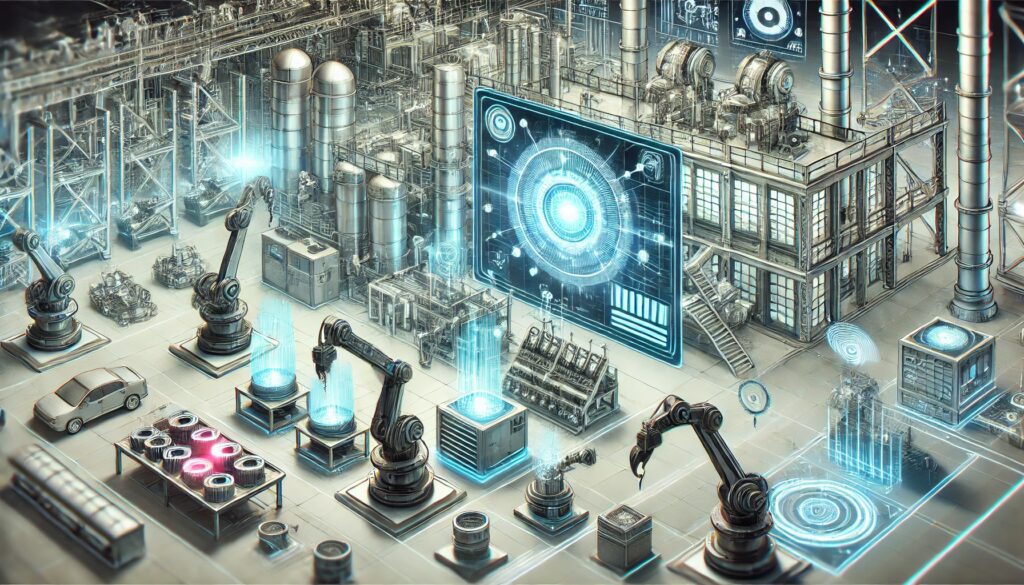
The Role of AI in Enhancing Digital Twins
The integration of Artificial Intelligence (AI) with digital twins has ushered in a new era of possibilities for manufacturing. While digital twins provide a real-time, dynamic model of a physical asset, AI takes it a step further by introducing the capability to learn and adapt. AI-powered digital twins can analyze vast amounts of data more efficiently, uncovering patterns that would be impossible for humans to detect.
For instance, machine learning algorithms within AI can study historical data and predict future outcomes with remarkable accuracy. In a manufacturing setting, this might mean anticipating the failure of a component weeks before it happens or optimizing production schedules to minimize waste and downtime. AI transforms digital twins from passive observers into active participants in the manufacturing process, continuously learning and improving operations without human intervention.
Furthermore, AI enhances the decision-making capabilities of digital twins. By processing real-time data, AI can recommend the best course of action in complex situations. This not only boosts efficiency but also reduces the cognitive load on human operators, allowing them to focus on strategic decisions rather than getting bogged down in day-to-day troubleshooting.
Real-World Applications: Success Stories from Industry Giants
Industry leaders across various sectors have already embraced digital twins, reaping significant benefits in the process. Let’s look at a few success stories that highlight how digital twins are making a difference.
Siemens, a pioneer in industrial automation, has implemented digital twins in its factories to optimize production lines. By simulating different production scenarios, Siemens can fine-tune processes without halting operations, resulting in a 30% increase in production efficiency.
General Electric (GE), another industrial giant, uses digital twins to monitor and maintain its fleet of jet engines. These digital twins track every aspect of engine performance, enabling GE to predict maintenance needs and reduce unscheduled downtime by 25%. This not only cuts costs but also improves safety and reliability for airlines using GE engines.
In the automotive industry, Tesla has taken the digital twin concept to the next level. Tesla creates digital twins of its cars, allowing the company to update vehicle software and diagnose issues remotely. This approach has significantly reduced the time required for vehicle recalls and repairs, enhancing customer satisfaction.
These examples demonstrate the transformative power of digital twins across industries, showcasing their potential to redefine manufacturing practices.
Overcoming Challenges: Implementing Digital Twins in Legacy Systems

While the benefits of digital twins are undeniable, integrating them into existing legacy systems presents challenges. Many manufacturers operate with older equipment that lacks the sensors and connectivity required for real-time data collection. This can make it difficult to create an accurate digital twin, especially in industries where upgrading machinery is cost-prohibitive.
However, there are ways to overcome these obstacles. One approach is to retrofit existing equipment with modern sensors and connectivity modules. This allows for the collection of real-time data without the need for complete system overhauls. Additionally, software solutions can be employed to bridge the gap between legacy systems and digital twins, ensuring seamless integration and data flow.
Another challenge lies in the cultural shift required to embrace digital twins. Employees accustomed to traditional methods may resist the change, fearing job displacement or an increased reliance on technology. To address this, manufacturers must invest in training and demonstrate how digital twins can enhance job roles rather than replace them. By fostering a culture of innovation and continuous improvement, companies can ease the transition and fully realize the benefits of digital twins.
The Impact on Supply Chain Management
Digital twins are not confined to the walls of the factory; their impact extends across the entire supply chain. By creating digital replicas of supply chain processes, manufacturers can gain unprecedented visibility into every stage of production, from raw material procurement to final product delivery. This visibility allows for more agile and responsive supply chain management, reducing the risk of disruptions.
For example, a digital twin of a supply chain can simulate the impact of a supplier delay on production schedules. By adjusting parameters in the simulation, manufacturers can explore different scenarios and develop contingency plans that minimize disruptions. This capability is particularly valuable in today’s globalized economy, where supply chains are increasingly complex and vulnerable to external shocks.
Moreover, digital twins can help optimize inventory management by predicting demand fluctuations and adjusting stock levels accordingly. This not only reduces the risk of stockouts but also minimizes the costs associated with holding excess inventory. In this way, digital twins contribute to a more efficient and resilient supply chain, capable of adapting to changing market conditions.
Cost Implications: Are Digital Twins Worth the Investment?
One of the most pressing questions for manufacturers considering digital twins is whether the investment is justified. Implementing digital twins requires significant upfront costs, including the installation of sensors, software development, and employee training. However, the long-term benefits often outweigh these initial expenses.
Firstly, the efficiency gains achieved through digital twins can lead to substantial cost savings. By optimizing production processes, reducing downtime, and minimizing waste, manufacturers can achieve higher output with lower input costs. In industries where margins are slim, these savings can make a significant difference.
Secondly, the improvement in product quality facilitated by digital twins can lead to higher customer satisfaction and fewer product returns, which in turn enhances brand reputation and market competitiveness. Additionally, the ability to predict and prevent equipment failures reduces maintenance costs and extends the lifespan of machinery, further increasing the return on investment.
Lastly, digital twins provide manufacturers with a competitive edge in an increasingly digitalized world. Companies that adopt digital twins early are better positioned to innovate and adapt to changing market demands, ensuring long-term success in a rapidly evolving industry.
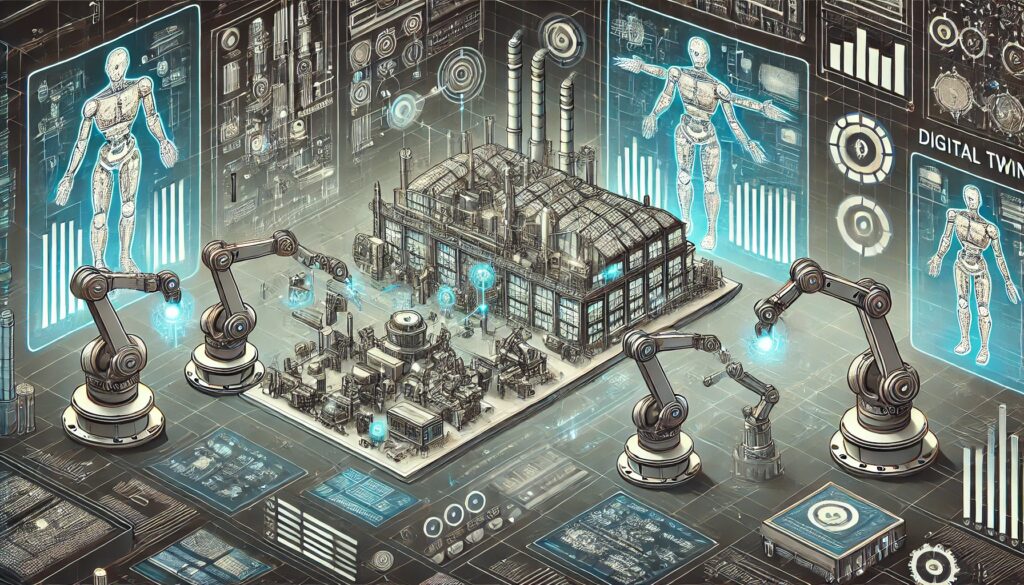
Improving Quality Control and Assurance with Digital Twins
Digital twins, virtual replicas of physical assets, systems, or processes, are revolutionizing quality control and assurance in manufacturing. By providing a real-time, data-driven simulation of production processes, digital twins enable manufacturers to detect and address potential defects before they occur, ultimately leading to higher-quality products and fewer recalls.
1. Real-Time Monitoring and Data Integration
Digital twins offer a dynamic, real-time view of the manufacturing process by continuously collecting and analyzing data from sensors embedded in machinery and production lines. This real-time monitoring allows manufacturers to identify variations in the production process that could lead to defects. For example, if a machine begins to operate outside of its optimal parameters—such as temperature, pressure, or speed—the digital twin can immediately flag this deviation, allowing operators to intervene before the issue affects product quality.
2. Predictive Analytics for Defect Prevention
One of the most significant advantages of digital twins in quality control is their ability to leverage predictive analytics. By analyzing historical and real-time data, digital twins can forecast potential defects before they manifest. For instance, in a complex assembly process, the digital twin can simulate the entire sequence and predict where and when errors are most likely to occur. This predictive capability enables manufacturers to take proactive measures, such as adjusting process parameters or scheduling maintenance, thereby preventing defects from occurring in the first place.
3. Virtual Testing and Optimization
Digital twins allow manufacturers to conduct virtual tests of their production processes without interrupting the actual production line. By simulating different scenarios, manufacturers can identify the most efficient and defect-free process configurations. For example, in the automotive industry, a digital twin of a car assembly line can be used to simulate various assembly methods to determine which one minimizes defects in the final product. This virtual optimization ensures that when the physical production occurs, it is as close to flawless as possible.
4. Enhanced Quality Assurance through Continuous Improvement
The feedback loop provided by digital twins supports continuous improvement in manufacturing processes. As data from production continues to flow into the digital twin, the system learns and adapts, refining its predictions and simulations over time. This continuous improvement process leads to increasingly accurate defect detection and prevention, ensuring that product quality is consistently high. Manufacturers can also use insights gained from the digital twin to make long-term improvements to their processes, materials, and designs, further enhancing quality assurance.
5. Reducing Recalls and Enhancing Product Reputation
The ultimate goal of integrating digital twins into quality control is to reduce the incidence of defective products reaching the market. By identifying and addressing potential issues before they lead to defects, manufacturers can significantly reduce the risk of product recalls. Fewer recalls not only save companies money but also protect brand reputation and customer trust. In industries where safety is paramount, such as aerospace or medical devices, the ability to guarantee product quality through digital twin technology can be a significant competitive advantage.
Future Trends: Where Are Digital Twins Headed?
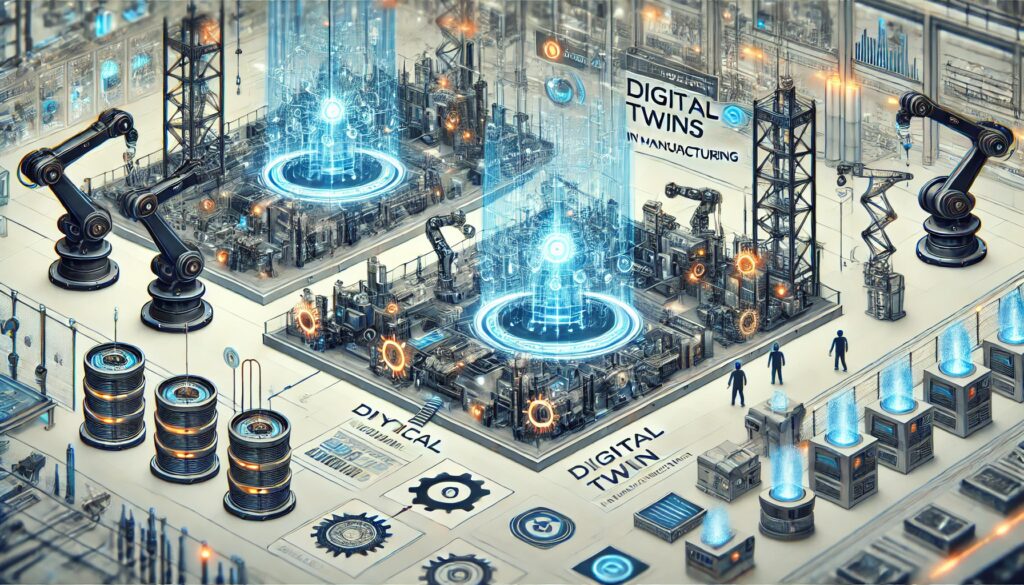
As the manufacturing landscape continues to evolve, the role of digital twins is expected to expand and adapt in exciting new ways. One emerging trend is the integration of 5G technology with digital twins. The ultra-fast data transfer capabilities of 5G will enable even more real-time interaction between physical assets and their digital counterparts, allowing for more precise and responsive manufacturing processes.
Another significant trend is the growing use of Edge Computing in conjunction with digital twins. Rather than relying solely on centralized cloud computing, edge computing processes data closer to where it’s generated—on the manufacturing floor. This reduces latency and enhances the speed at which digital twins can analyze and respond to data, making them even more powerful tools for real-time decision-making.
Moreover, the Internet of Things (IoT) will continue to play a critical role in the evolution of digital twins. As more devices and machinery become interconnected, the data feeding into digital twins will become richer and more diverse. This will allow manufacturers to create more detailed and accurate digital replicas, further improving efficiency, quality, and flexibility in production.
Looking further ahead, the concept of cognitive digital twins is gaining traction. These advanced twins not only simulate and analyze data but also use AI to make autonomous decisions. Cognitive digital twins could eventually manage entire production lines or factories with minimal human intervention, pushing the boundaries of what’s possible in automated manufacturing.
How to Get Started with Digital Twins in Your Factory
Implementing digital twins in your factory might seem like a daunting task, but with careful planning and a strategic approach, it’s entirely achievable. The first step is to identify the areas of your production process that could benefit most from a digital twin. This might be a particularly complex machine, a critical production line, or even the entire factory, depending on your needs and resources.
Once you’ve identified the target, the next step is to collect data. This involves installing sensors and other data-gathering tools on the physical asset you wish to replicate. The quality and quantity of this data are crucial—accurate, real-time data is what makes a digital twin effective.
Next, choose the right software platform to build your digital twin. Many companies offer specialized platforms for creating and managing digital twins, with features ranging from basic visualization to advanced analytics and AI integration. It’s important to select a platform that aligns with your specific needs and can scale as your digital twin expands.
Employee training is another critical component of a successful implementation. Operators and engineers need to understand how to interact with and interpret data from the digital twin. This might involve learning new software or developing new skills in data analysis and interpretation.
Finally, start small and scale up. Begin with a pilot project, such as a single machine or production line, and use it as a learning experience. As you become more comfortable with the technology and start seeing the benefits, you can gradually expand your digital twin to cover more of your manufacturing operations.
The Environmental Benefits of Digital Twins

Beyond boosting efficiency and product quality, digital twins also offer significant environmental benefits. By optimizing processes and reducing waste, digital twins help manufacturers lower their overall environmental footprint. For example, by predicting equipment failures and maintenance needs, digital twins can extend the lifespan of machinery, reducing the need for frequent replacements and minimizing the resources consumed in production.
Digital twins also enable energy efficiency improvements. By monitoring and analyzing energy usage in real-time, they can identify areas where energy is being wasted and suggest ways to reduce consumption. This might involve adjusting machine settings, rescheduling production to off-peak energy hours, or even reconfiguring the layout of the factory to improve energy flow.
In addition, digital twins can facilitate more sustainable production practices. For instance, by simulating different materials or production methods, manufacturers can explore ways to reduce the environmental impact of their products. This could mean using fewer resources, reducing emissions, or minimizing waste during production.
By adopting digital twins, manufacturers not only enhance their operational efficiency but also contribute to a more sustainable and environmentally-friendly industry.
What to Watch Out for: Potential Risks and Concerns
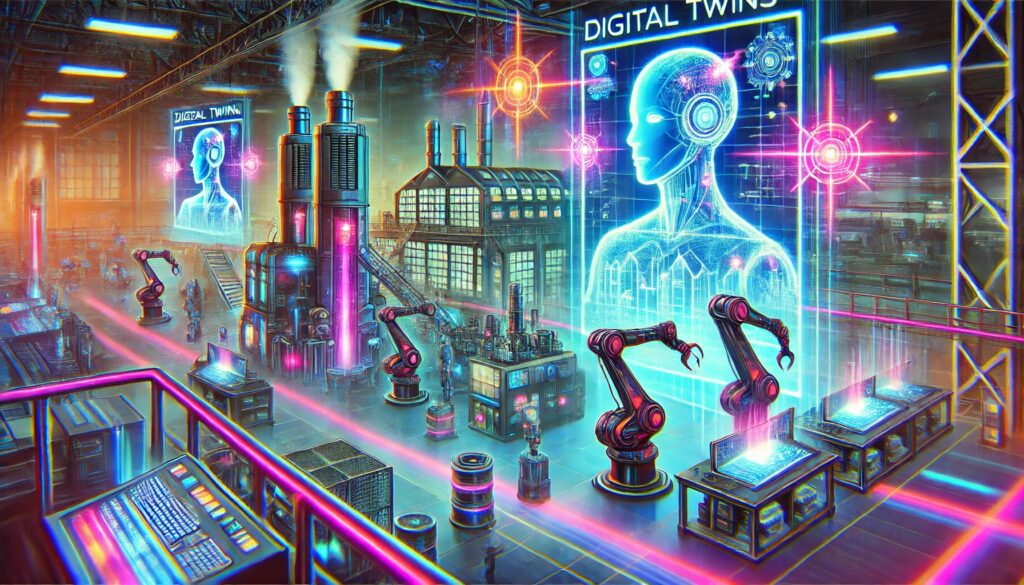
While the advantages of digital twins are clear, it’s important to be aware of potential risks and challenges that come with their implementation. One of the most significant concerns is data security. Digital twins rely on vast amounts of real-time data, much of which is sensitive and proprietary. If this data is compromised, it could lead to severe operational disruptions or even intellectual property theft.
To mitigate this risk, manufacturers must invest in robust cybersecurity measures. This includes encrypting data, securing networks, and regularly updating software to protect against the latest threats. Additionally, companies should establish clear protocols for who can access and control the digital twin, ensuring that only authorized personnel can make critical changes.
Another concern is the complexity of implementing and maintaining digital twins. Creating an accurate and functional digital twin requires advanced technical expertise, and the learning curve can be steep. To address this, manufacturers might need to partner with specialized technology providers or invest in extensive training for their teams.
There’s also the risk of over-reliance on digital twins. While they are powerful tools, they should complement, not replace, human decision-making. Manufacturers must strike a balance between leveraging the insights provided by digital twins and applying human judgment, especially in complex or unprecedented situations where AI might not have all the answers.
Lastly, consider the potential for disruption during the implementation phase. Integrating digital twins with existing systems can be a complex process, and there may be temporary disruptions as new technologies are introduced. Careful planning and a phased approach can help minimize these disruptions and ensure a smooth transition.
Final Thoughts: The Game-Changer in Modern Manufacturing
As digital twins continue to evolve, their impact on the manufacturing industry will only grow. They offer a powerful way to enhance efficiency, improve product quality, and reduce environmental impact—all while providing manufacturers with the tools they need to stay competitive in an increasingly digital world. By understanding both the opportunities and the challenges, manufacturers can make informed decisions about how best to integrate digital twins into their operations, paving the way for a more innovative and sustainable future in manufacturing.
Frequently Asked Questions (FAQ)
What is digital twinning?
At the heart of modern technological advancements, digital twinning is a powerful concept transforming industries. A digital twin is essentially a virtual replica of a physical object, system, or process. This replica mimics the real-world counterpart in real-time, allowing companies to simulate, predict, and optimize processes and systems without real-world testing.
What is a digital twin?
A digital twin is a virtual model that mirrors a physical object, system, or process in real-time. It gathers data from sensors and devices to reflect changes and predict outcomes in the real world, helping businesses make more informed decisions.
How does a digital twin work?
Digital twins operate by collecting real-time data from physical entities through connected sensors. This data is fed into algorithms, often powered by artificial intelligence (AI) and machine learning, to simulate, monitor, and predict the performance or behavior of the real-world counterpart.
What industries benefit from digital twinning?
Many industries benefit from digital twins, including:
- Manufacturing: To enhance product design and improve operations.
- Healthcare: For personalized medicine and testing treatments virtually.
- Smart Cities: To optimize infrastructure and resources.
- Aerospace & Automotive: For predictive maintenance and system analysis.
How is digital twinning different from simulation?
While both digital twins and simulations model processes or systems, a digital twin is an ongoing real-time replica that continuously receives data from the physical object. Simulations, on the other hand, are often static and used for specific scenarios rather than real-time monitoring.
What are the key technologies behind digital twins?
The primary technologies driving digital twins are:
- Internet of Things (IoT): For data collection through sensors.
- AI and Machine Learning: For analyzing data and predicting outcomes.
- Cloud Computing: To handle large data sets and complex algorithms.
- 5G Networks: For fast, reliable data transmission.
Can digital twins help with predictive maintenance?
Yes, predictive maintenance is one of the key uses of digital twins. By continuously monitoring the condition of equipment, digital twins can predict when a part will fail, allowing businesses to perform maintenance before a breakdown occurs, reducing downtime and costs.
What are the benefits of using digital twins?
The benefits of digital twins include:
- Reduced downtime through predictive maintenance.
- Increased efficiency by optimizing processes.
- Cost savings by reducing the need for physical prototypes and minimizing risks.
- Better decision-making with real-time data insights.
- Improved collaboration across teams and locations.
What are the challenges associated with digital twinning?
Some of the main challenges include:
- Data security: Protecting the real-time data from cyberattacks.
- Scalability: Managing the complex infrastructure required for large-scale digital twins.
- Skill shortages: The need for experts in AI, IoT, and data analytics to interpret and manage the digital twin.
How do IoT and AI enhance digital twins?
IoT devices provide real-time data from physical entities, while AI processes this data to uncover patterns, predict issues, and optimize performance. Together, they make digital twins smarter and more reliable by continuously learning and adapting to changes in the physical world.
What is the future of digital twins?
The future of digital twins looks bright, with increasing adoption across industries. As 5G becomes more widespread, digital twins will be able to function with even greater speed and accuracy. By 2030, digital twinning could be a common tool in industries like smart cities, construction, and energy, helping to drive innovation and sustainability.
Can digital twins help with sustainability?
Absolutely. Digital twins can optimize resource usage, reduce waste, and improve energy efficiency. For example, in construction, they can simulate energy consumption to build more sustainable structures, and in renewable energy, they help maximize output while minimizing environmental impact.
How do digital twins support smart city initiatives?
In smart cities, digital twins are used to simulate and manage infrastructure, traffic systems, and resource distribution. City planners can use this technology to predict congestion, optimize energy consumption, and improve services like waste management and public transportation.
Are there privacy concerns with digital twins?
Yes, especially in sectors like healthcare and smart cities, where sensitive data is involved. To address these concerns, organizations must implement robust data protection protocols and adhere to privacy regulations like GDPR to ensure personal and critical information remains secure.
How can my business implement a digital twin?
Start by identifying a process or system that would benefit from real-time monitoring or predictive analytics. Next, ensure you have the right IoT infrastructure in place to gather data. Finally, work with experts in AI, machine learning, and data analytics to create and manage your digital twin effectively.
How does 5G impact digital twinning?
5G enables faster and more reliable data transmission, making digital twins more responsive and accurate. As 5G networks expand, digital twins can process larger data sets in real-time, leading to better predictive modeling and more precise simulations.
Resources
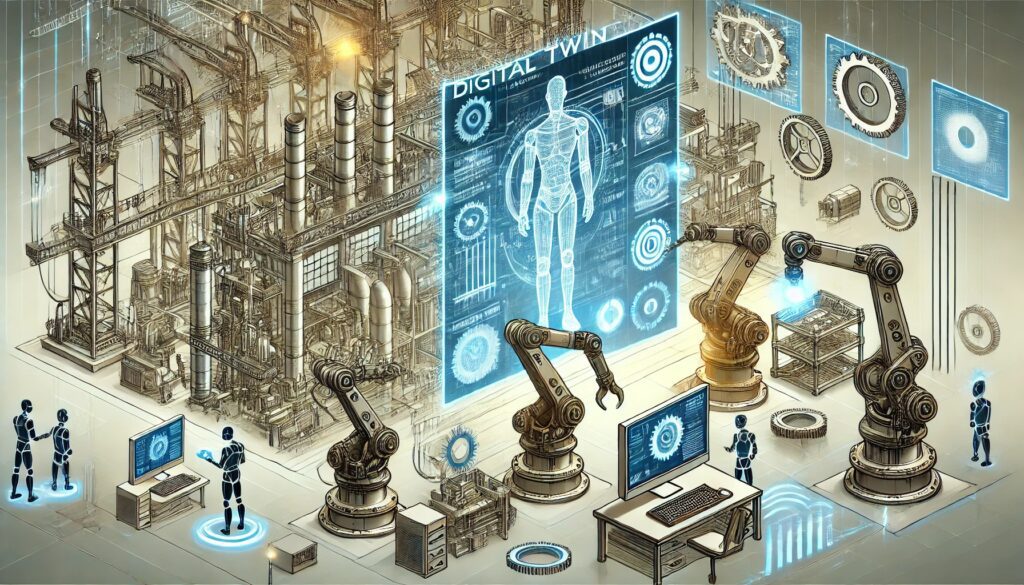
Digital Twin Technology in Manufacturing
- Book: Digital Twin: Mitigating Unpredictable, Undesirable Emergent Behavior in Complex Systems by Ramesh V. R. and James Cecil
- Online Course: Digital Twins for Industrial Applications on Coursera
- Research Paper: “The Role of Digital Twin in Industry 4.0” by Qi, Douglas, and Ward
AI and Machine Learning
- Book: Machine Learning for Dummies by John Paul Mueller and Luca Massaron
- Online Course: Machine Learning by Andrew Ng on Coursera
- Research Paper: “Artificial Intelligence and Machine Learning in Industry 4.0” by Jay Lee, Behrad Bagheri, and Hung-An Kao
Predictive Maintenance
- Book: Predictive Maintenance in Smart Factories by Tien Pham
- Online Course: Predictive Maintenance, Machine Learning, and IoT on Udemy
- Research Paper: “A Survey of Predictive Maintenance: Systems, Purposes, and Approaches” by Saeid Mosallam, Jayanth Y. Prakash, and Johan B. Steen
IoT in Manufacturing
- Book: Internet of Things (IoT) in Manufacturing by Ovidiu Vermesan and Peter Friess
- Online Course: IoT and the Smart Factory on LinkedIn Learning
- Research Paper: “IoT-Based Smart Manufacturing System: A Real-Time Context-Aware Robotic Hand” by Mohamed Abdur Rahman, Khandakar A. Mahmud, and Mohammad A. M. Taj
Data Analytics and Integration
- Book: Data Analytics for Manufacturing: Methods and Applications by Fugee Tsung and Ali Mosleh
- Online Course: Data Science and Big Data Analytics on edX
- Research Paper: “Big Data Analytics for Manufacturing Internet of Things: Opportunities, Challenges, and Enabling Technologies” by Wang, Tao, and Shahriar
Industry 4.0 and Smart Manufacturing
- Book: Industry 4.0: Managing The Digital Transformation by Alp Ustundag and Emre Cevikcan
- Online Course: Smart Manufacturing and Industry 4.0 on Coursera
- Research Paper: “Smart Manufacturing: Past Research, Present Findings, and Future Directions” by Saeed Rahimi and Ali N. Tootooni
Advanced Manufacturing Technologies
- Book: Additive Manufacturing Technologies: 3D Printing, Rapid Prototyping, and Direct Digital Manufacturing by Ian Gibson, David Rosen, and Brent Stucker
- Online Course: Introduction to Additive Manufacturing on FutureLearn
- Research Paper: “Advanced Manufacturing Technologies and Their Adoption: A Review” by Anca Draghici and Cristiana Radulescu
Real-Time Monitoring and Control
- Book: Real-Time Systems: Design Principles for Distributed Embedded Applications by Hermann Kopetz
- Online Course: Real-Time Embedded Systems on Coursera
- Research Paper: “Real-Time Monitoring and Control in Smart Manufacturing: Advances, Challenges, and Future Directions” by Jian Liu, Heiko Gebhardt, and Bojan Milovic
These resources provide comprehensive insights and practical knowledge for understanding and implementing Digital Twins, AI, and related technologies in manufacturing.